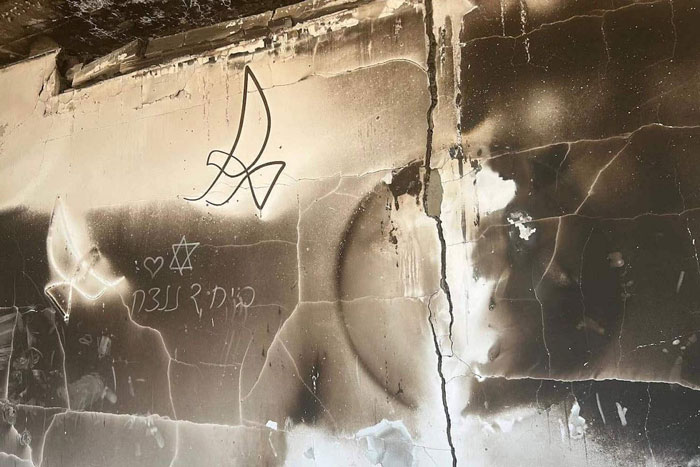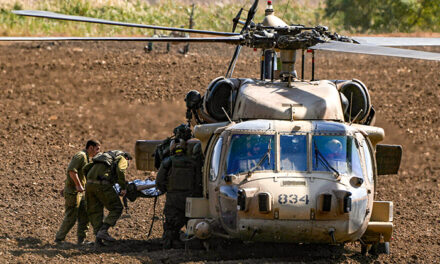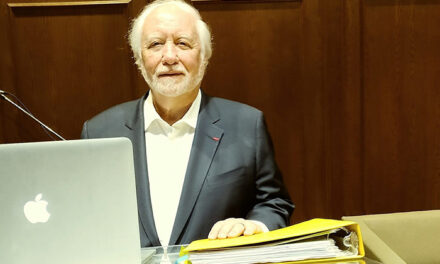Scrawled on a destroyed building at Kibbutz Berri, “Together we will win.” Photo courtesy of Amelie Botbol.
As we approached the devastated villages of southern Israel, including Kibbutz Be’eri, the GPS navigation system insisted we “continue straight on Road 232,” commonly dubbed “The Road of Death” by survivors of Hamas’s Oct. 7 massacre.
What was once a very hospitable community can no longer be entered uninvited. As we waited for our host to arrive, we noticed dozens of cars parked at the entrance to the kibbutz, and yet there was not a sound other than distant explosions in the Gaza Strip.
The Future?
Be’eri resident Sharon Shevo, who nearly lost both his arm and entire family in the invasion, would serve as our guide on the visit. Shevo works in construction engineering and is involved in the physical rehabilitation of the kibbutz. He had agreed to walk us through destroyed neighborhoods and show us where new housing units will welcome back residents a few years from now.
“We are currently in the complex stages of planning the reconstruction,” Shevo told JNS.
“The security level has not yet reached a point where we can see ourselves returning permanently; the war has not yet ended. In the meantime, we are planning what the future Be’eri will look like,” he said.
At the moment, he explained, there are no street lights in the kibbutz, and no functioning grocery story or school. However, the cafeteria still operates, serving lunch and dinner to a handful of residents.
It is only the fifth time since Oct. 7 that Shevo has agreed to walk visitors through the streets of Be’eri and relive the most dreadful day of his life.
“There is the concept of a house versus a home. Our houses were destroyed and we no longer have a home,” he said.
Closed To Visitors?
One hundred and one residents of Kibbutz Be’eri were murdered by Hamas on Oct. 7. Thirty were taken hostage and 11 remain in captivity.
At Be’eri’s now infamous dental clinic, where five members of the kibbutz, including three of its civil-defense squad—Gil Buyum, Shachar Zemach and Eitan Hadad—and two staff members, Amit Man and Dr. Daniel Levi Ludmir, were murdered by Hamas, we encountered a delegation of university vice chancellors from India.
Driving a club car around the kibbutz with his daughter, Hassi Yehezkel, a resident of Be’eri, stopped and greeted us. She expressed her joy at being home, though she also said it was much too soon for her family to return permanently.
“Some residents believe that we shouldn’t let visitors enter the kibbutz, and [then there are] those including me and my family who believe it is essential for us to show others what happened here,” Ella Gelbard, who survived the assault, told JNS.
Time To Start Over
“This disaster could be erased in a moment if we don’t work to bring our stories to the media and the population,” she said.
Gelbard’s husband grew up on the kibbutz. His parents were founders and his four siblings all lived in Be’eri up until Oct. 7.
“I don’t know if I can say that we’re OK emotionally. I’m not sure. But physically we’re OK. A few of our houses await demolition, after they were either burnt by Hamas or used as a temporary base for the terrorists. Each house tells a different story,” she said.
As we stopped at an empty space in a row of houses, a few of them somehow untouched, Shevo explained that the hole used to be the house of Yossi Sharabi, from which he and his daughter’s boyfriend, Ofir Engel, were kidnapped by Hamas.
On Jan. 16, Sharabi’s death was confirmed in absentia, after he was murdered by Hamas in captivity. Engel was released as part of a late November ceasefire agreement between Israel and Hamas that freed 105 captives, mostly women and children.
“It’s A Community; It’s Values”
Asked whether he feared that erasing ravaged neighborhoods could lead to denialism, Shevo said he and all the residents know it happened and that that was enough for him. It is now time to start over, he said.
“I want to see Be’eri become better. I want residents to be happier. We can’t live side by side with reminders of our loss, we must continue to live our lives. The residents lost their loved ones here but at the end of the day Be’eri is our home,” he said.
“A home is not just walls; it’s a community; it’s values transmitted to children. We have families and generations who have been on the kibbutz since 1947. We need to rebuild and because Oct. 7 devoured our lives, we will rebuild from scratch,” he added.
“We will destroy neighborhoods that were damaged and rebuild on the kibbutz but away from the neighborhoods where our loved ones were murdered, at least in the beginning. It will help our souls heal,” Shevo continued.
Kibbutz Be’eri is set to receive nearly $100 million for rebuilding efforts, the largest sum to date allocated to any of the Gaza-border communities invaded by Hamas terrorists on Oct. 7.
New Security?
The government funding is part of the Tkuma (revival in Hebrew) Directorate, which was established to oversee reconstruction in the communities of southern Israel impacted by the attack. It is set to deliver the final building plans to Jerusalem in two months.
In many instances on Oct. 7, bomb shelters and safe rooms did not provide hermetic protection against the invasion. Shevo explained that no security mechanism is flawless.
“It’s impossible to predict the next scenario. We can’t take a house and seal it. We can’t live in a dungeon,” he said.
“There is always the risk that someone manages to break in or burn it,” he added.
Shevo has not received information on what security systems will be added to the new construction. He predicts that they will likely add an inside lock to safe rooms.
Nearly 350 Hamas terrorists, including 100 members of the terror group’s Nukhba Force, managed to infiltrate Kibbutz Be’eri in southern Israel on Oct. 7 due to a catastrophic failure by the Israeli security forces, according to the first part of the IDF’s internal probe into the attacks.
After regaining control of the kibbutz, the IDF evacuated 190 bodies of terrorists.
“This investigation will not give me my life back. This tremendous failure won’t change much now that it is written on paper. There was a failure here which is impossible to interpret,” said Shevo.
“Nobody will bring back those who died. My life is all over the place. I don’t know when I will have a house again or what kind of life awaits me. All I deal with all day is grief and rehabilitation. None of this resembles the life I used to live,” he added.
Killed In Each House
In Shevo’s neighborhood, out of 42 houses, 36 were impacted by Hamas’s massacre.
“This neighborhood used to be paradise. A lot of space, beautiful views. In this street lived eight families, in each house someone was murdered,” he said.
We first entered Avida Bachar’s house. Bachar, an amateur cyclist, lost his wife, Dana, his 15-year-old son Carmel and his right leg in the assault.
“We do everything together. Our children are the same ages. Although he was targeted with bullets and grenades, he survived,” said Shevo.
“For 12 hours, his daughter, Hadar, tried to help as she witnessed her mother and brother’s death and her dad losing consciousness,” he added.
Impossible To Forget
On the other side of the street from Bachar’s house lived Hamas captive Eli Sharabi, who lost his wife and two daughters in the invasion and whose brother Yossi was murdered in captivity. Eli is presumed to still be alive.
As we entered Shevo’s house, he explained how he thought of every element of his home, from the pantry to the architectural staircase he designed.
On Oct. 7, Shevo left the kibbutz early in the morning to go on a bicycle ride just a couple miles away. An amateur cyclist, he was training for the Epic Israel competition when he was ambushed by Hamas terrorists.
He was eventually rescued by the IDF close to the site of the Supernova music festival. His son Shaked, an IDF officer, battled the terrorists for hours to protect the rest of the family under siege in their home, even as the terrorists used the house as a military base and ended up setting the property on fire while Shevo’s family was still inside. Fortunately, they all survived.
Looking through the rubble, Shevo grabbed a burnt chanukkiah and explained its significance.
“My daughter’s name is Rimon [pomegranate in Hebrew], as you can see each candle holder is a pomegranate” he said. “It will all go once the house is destroyed.
“It is impossible to forget what has happened to us, but whatever we can leave behind, you can trust that we will,” he continued.
Tastes From Home
A lunch break at the nearly deserted Be’eri cafeteria left us wondering how hectic and lively it likely was before Oct. 7.
The visit ended with a stop at Kibbutz Be’eri’s dairy farm, where Dror Or, who was killed on Oct. 7 and whose body is being held by Hamas in Gaza, worked for 15 years.
At the farm we met Tom Carbone, who also produces wine in Be’eri. He lost his mother in the Oct. 7 invasion, and was close to Or. “Dror was a chef and he did culinary events. I ran into him making a sauce. I tasted it and told him exactly what was in the sauce, that’s how we first bonded,” Carbone told JNS. “Dror believed in the high potential of the dairy farm and he invested a lot in it. It was a project for him which he kept on thinking of making bigger and more successful,” he continued.
“Dror always said whenever he had a chance that he was keeping me close to him. He knew one day I’d work at the factory and I think he’d be very proud,” added Carbone.
All the materials used to make the dairy products are from Be’eri. As Carbone goes back and forth from Be’eri to a hotel at the Dead Sea where most of Be’eri residents currently live, he makes sure to bring cheeses with him, and opens a mini market there to provide the residents with tastes from home.
Discussing the rebuilding of the kibbutz, Carbone seemed optimistic. “I’m very happy that things are advancing, we need to move on,” he said. “We can’t stay behind. I want to come back and if they don’t start rebuilding, I won’t be able to,” he added.











